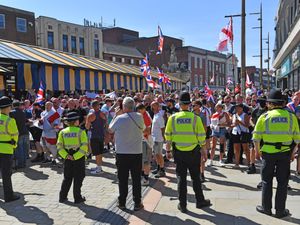Five hangings in a day at Shrewsbury Jail . . . for burglary
Outdated, largely Victorian, and very, very overcrowded, Shrewsbury Jail is a venerable old lady who has done her time – with a fair share of dark moments in her grisly past[gallery] .
Those cell doors will soon clang shut for the last time as the jail which has been at the heart of Shrewsbury for over 200 years is closed down, having outlived its usefulness, and having itself being condemned as too old and too costly.
The Dana has never had that ring which sends a chill down the spine, unlike, say, Dartmoor, Strangeways, and Holloway.
Nevertheless, there will be many Salopians who have their own "inside story" of the jail at Shrewsbury.
For all its forbidding aspect, it is unlikely that old lags will have Shrewsbury down as one of the toughest institutions within the prison service.
Even the prison food was once praised for its high standard in a "Good Jail Guide".
The cells have integral sanitation – the days of slopping out are over – power, and television. Back in 2004 well-behaved inmates could enjoy the reward of being given a Freeview television box, meaning they could access dozens of channels, including the shopping channel.
But Shrewsbury has a very dark side. For many years it was a place of execution, which in older times was carried out in public and drew huge crowds in an unwholesome festive atmosphere. People used to turn up early to make sure they got a good place, and posters were produced as souvenirs.
The practice was to bury the body of the executed offender within the prison precincts.
During a redevelopment in 1972 , the remains of 10 unnamed prisoners executed at Shrewsbury Prison were dug up. Nine were cremated and one set was handed over to relatives.
This 10 would have been just the tip of the iceberg – scores of prisoners were hanged at Shrewsbury, for crimes as minor as stealing sheep, and they included at least one woman. In April 1822 five prisoners were hanged for burglary in just one day.
Escapes? Yes, those too, including an unusual escape in reverse in 1966 in which a man from Dawley actually scaled the perimeter wall and broke in to the jail. There has been at least one rooftop protest, and another famous rooftop incident when Santa Claus – actually prankster Poddy Podmore – scaled the walls and threw down gifts to the prisoners in December 1977.
Famous inmates have included one of the great train robbers, Robert Welch, who was there for a time in 1964 after being given a 30-year sentence.
Another was Sidney Noble, known as "Doctor Death", who interrupted his 10-year sentence there in 1979 to marry a woman from Kettering at Shrewsbury Register Office. Noble was released in 1985 but carried out a further series of crimes in which he posed as a doctor to drug and steal from elderly people, and received six life sentences at the Old Bailey. He was murdered at a top security prison in 2005.
Historically Shrewsbury's jail was in School Gardens, which had taken over the role from the jail at Shrewsbury Castle which had become so ruinous that in the late 16th century prisoners were able to make an escape attempt by the simple method of taking stones out of the wall. The School Gardens prison was replaced by a new jail on the present site which was completed in 1793 at a cost of £30,000.
Prison uniform for criminal prisoners was a woollen jacket with blue and yellow stripes before conviction, and brown and yellow stripes after conviction, together with a waistcoat and cap.
Discipline within the walls was not necessarily always good. In 1822 a Mr Cartwright, the jailer, was compelled to resign "on account of extreme laxity of his government, under which were was gross immorality and drunkenness among both prisoners and warders." Nevertheless, he still got a pension of £133.
In 1877 Shrewsbury jail, with all other county jails, was transferred from the control of the Quarter Sessions to that of the Home Office and its interior arrangements were soon afterwards entirely remodelled.
One of the few original features of the earlier 18th century building surviving today is Thomas Telford's gatehouse. Above the old entrance is a bust of the great prison reformer John Howard who had visited Shrewsbury on several occasions between 1774 and 1776.
Under his influence the jail was whitewashed and ventilated and the taking of "garrish", which was an entrance fee customarily demanded from new prisoners, was forbidden. Howard visited Shrewsbury again in 1788 and suggested alterations and improvements in the design of the new prison, although he did not live to see it completed.
Shrewsbury is one of the oldest prisons in the country and countless prisoners have had a stay at Her Majesty's Pleasure in the cells, which are all 13ft by 7ft with a small window high up on the facing wall.
Naturally, not all of them have been content to stay.
In October 1961 two prisoners used a rope and home-made hook to get over the wall and were at large for several days before being recaptured in Manchester.
Shrewsbury's last public hanging was on April 11, 1863, when 30-year-old Edward Cooper was executed for a murder at Baschurch. It was particularly popular, with numbers watching nearly 10 times more than the previous execution, according to a Shrewsbury Chronicle report. The crowds were "perched as thickly as crows in a densely-populated rookery."
The 20th century saw eight executions, all for murder. The condemned men were: Richard Wigley, of Shrewsbury (executed March 18, 1902); Thomas Cox, of Ludlow (December 19, 1917); William Griffiths, of Eccleshall (July 24, 1923); Frank Griffin, of Bolton (January 4, 1951); Harry Huxley, of Holt, near Wrexham (July 8, 1952); Donald Neil Simon, a former Canadian soldier, of Slough (October 23, 1952); Desmond Donald Hooper, of Atcham (January 26, 1954); and George Riley, of Shrewsbury (February 9, 1961). Those carried out in the 1950s were conducted by Albert Pierrepoint, Britain's last, and most famous, hangman.
As an era comes to an end and Shrewsbury's prison shuts, a question hangs in the air: After such an extraordinary past, what can possibly be an appropriate use for the building in the future?
Have YOU got any memories of Shrewsbury prison? Drop a line to Toby Neal, Shropshire Star, Ketley, Telford, Shropshire TF1 5HU, or tneal@shropshirestar.co.uk on email.



